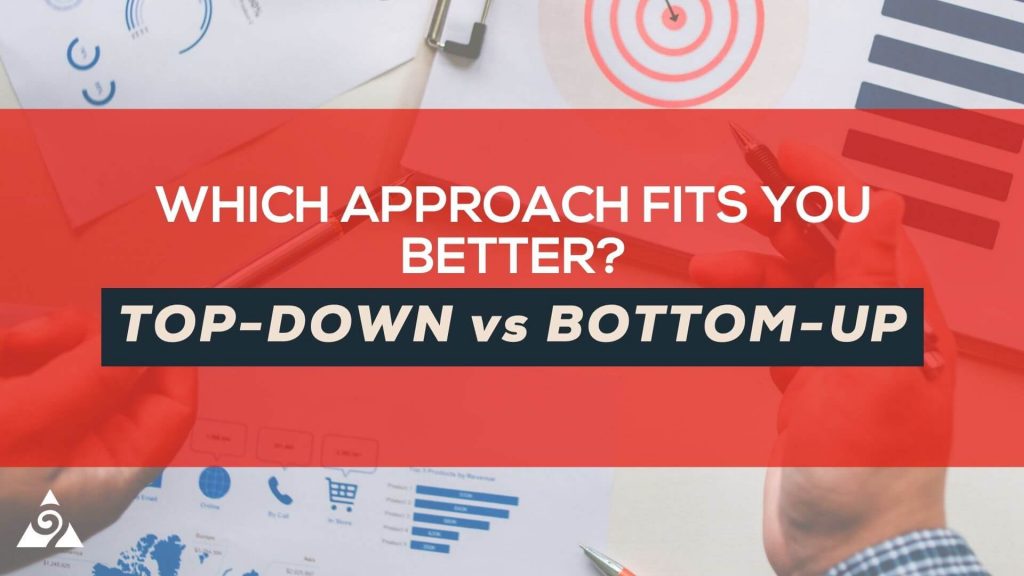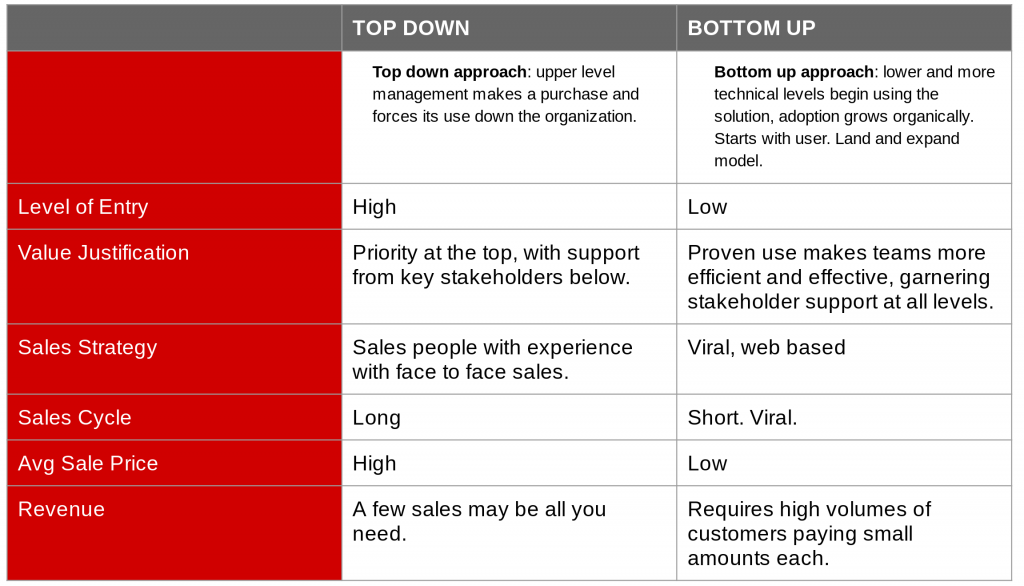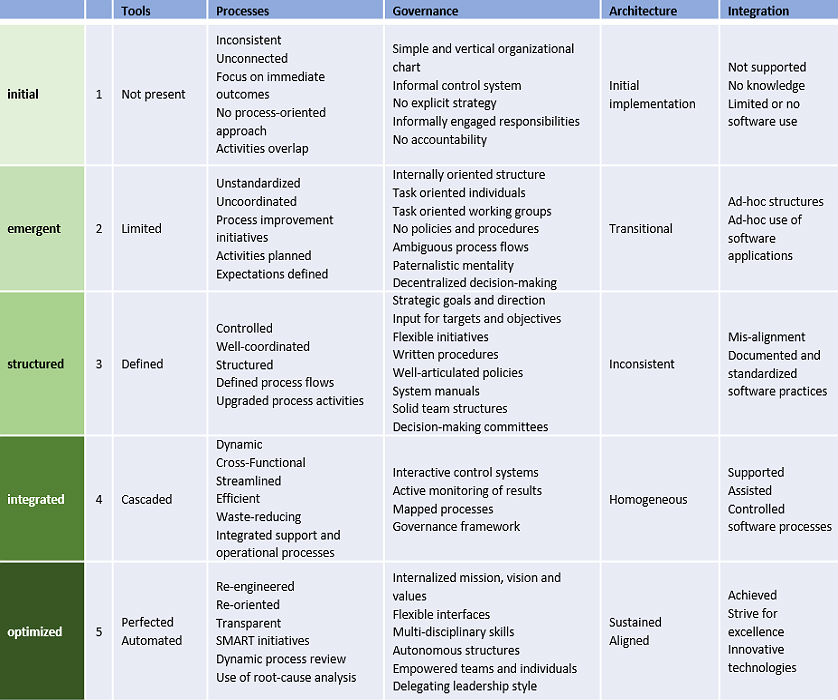Choosing the right management style for your business is key to your success. There are two popular options: top down vs bottom up.
Before you can pick the right management approach, it’s important to take the time to fully understand these two models. While they are not difficult concepts to comprehend, there are a lot of elements to them. Therefore, it can be difficult to grasp the depth and nuance in these approaches to planning in management.
We will break down the top down and bottom up models in a way that is digestible and useful (we hope) to all managers and business owners, the veterans and the newbies. This blog covers everything from top down and bottom up communication to the pros and cons of each model.
- What Is Top Down Planning?
- What Is Bottom Up Planning?
- Top Down vs Bottom Up Approach
- Top Down vs Bottom Up for SaaS
- Which Model Is Right For Your Company?
- Combining Top Down and Bottom Up
- Hiring an External Marketing Management Team
What Is Top Down Planning?
If you are new to management, you may be wondering, what is a top down approach? The traditional approach to business planning is top down meaning that the process starts with upper management and moves downward.
The top down model works best in companies with a clearly defined hierarchical structure. Upper management delivers goals and tasks to lower management to execute. Communication is often one-way from the company’s leadership down to the employees.
Here are some common characteristics of top down approach:
- Upper management is responsible for initiating projects and sales.
- Upper management purchases software and lower-level employees adopt the software.
- Lower-level employees complete tasks they are given and submit them to management for approval and implementation.
- Managers give feedback to employees.
Top Down Examples
Many companies, especially older, larger companies use the top down model of strategy, planning, and development. For example, the top down approach to software design was started by IBM. However, these days, IBM actually uses more of a mix of top down and bottom up.
Top down is also specific to certain industries. Industries that have a high level of regulation and need for consistency often rely on a top down model. Some examples include:
- Architecture
- Banking
- Military and Defense
- Intergovernmental Organizations (IGOs)
- Public Health
- Human Resources
What Is Bottom Up Approach?
The bottom up approach is essentially the opposite of top down. With bottom up planning, specific goals are set by the lower levels of workers in the company and eventually work their way up to become part of the larger company’s goals. It’s kind of like going backwards up a funnel.
Some characteristics of the bottom up approach include:
- There is company-wide collaboration, communication, and sales efforts.
- Software use and structures develop organically from what employees are already doing.
- Lower-level employees have a voice in what happens.
- Both employees and managers give and receive feedback.
Bottom Up Examples
Many start ups and Software-as-a-service (SaaS) companies are adopting a bottom up approach. We’ll discuss why that’s happening later. For now, here’s a list of some of the most notable bottom up organizations:
- Zoom
- Slack
- Sony
- The New York Times
- Ernst & Young
Top Down vs Bottom Up Approach
Let’s explore the major differences between top down vs bottom up project management, planning, and development.
BENEFITS OF a TOP DOWN Model
A top down model centralizes decision-making and execution in the hands of a small group of executives. This allows for processes to happen faster than they might if dozens of people in different departments were giving input before decisions could be finalized.
Consistent Goals and Structures
In top down planning, business goals and company values are set by founders, owners, and upper management. Therefore, the goals and values are generally the same across departments. This alignment minimizes confusion and increases efficiency. Employees have clear expectations for their work.
Bigger Sales
One of the advantages of top down development is the ability to make larger sales because the sales effort is centralized to one or a few owners and executives. Obviously, if given the choice anyone would prefer bigger deals and larger contracts.
Disadvantages of Top Down Planning
When structures, goals, and tasks are pushed down from upper management, there may be a disconnect. Executives may be out of touch with the abilities and attitudes of their employees. This could lead to unrealistic expectations and a lack of employee motivation.
Limited Creativity
Your employees may have skills and talents that could be advantageous for the company. However, if workers are not given the freedom to problem solve on their own, those talents may be going to waste. These top down management disadvantages could actually be costing you money!
BENEFITS OF a Bottom Up Model
Using a bottom up approach eliminates many of the pitfalls of the top down approach including lack of employee motivation and limited creativity.
Increased Employee Engagement
One of the biggest advantages of bottom up planning is employee engagement. When employees have a say in what work they do and what direction the company takes, they feel more connected to the company and more valued. This improves retention and productivity.
Values Diversity
A group of executives may hold a limited range of perspectives and life experiences. Tapping into the larger range of perspectives held by all stakeholders, including low-level workers, in a company can increase innovation. Collaboration leads to creative problem-solving and gives companies an advantage in competitive markets such as SaaS.
For more tips on building a successful SaaS company, check out our core tactics for SaaS growth.
Disadvantages of Bottom Up Planning
Can there be too much of a good thing? When it comes to bottom up project management, there can be. Bottom up planning requires a lot of coordination. This means it often uses more time and resources than the top down approach. It can be difficult to make quick changes and decisions.
Lack of Cohesion
When everyone has a say in a company, there are likely a lot of different opinions being voiced. Some of those opinions may not align with the overall goals and values of the company. Furthermore, sub goals and plans set by various departments may contradict each other hindering productivity and growth.
Top Down vs Bottom Up for SaaS

For new SaaS business owners and start up founders, asking yourself basic questions like this is an excellent way to determine which management style fits you best.
To keep yourself up-to-date on everything SaaS-related, sign up for our exclusive SaaS newsletter delivered right to your inbox.
Pros OF Top DowN For SaaS SaleS
SaaS is a quickly evolving, competitive market. For example, the number of marketing tech SaaS solutions has grown from 947 solutions in 2014 to 8,000 solutions in 2020. That’s a 745% increase in six years!
“The number of competitors for SaaS firms starting around 2012 were less than three on average. By the end of 2017, every SaaS startup faced competition from nine other firms competing in the same SaaS market segment.”
Using a top down approach to SaaS sales often means larger contracts. Negotiating larger contracts allow companies to lock out their competitors for longer periods of time. They also, many times, will come with additional training, maintenance and support contracts – making you super sticky and creating significant barriers to change. Because of this, companies using top down can count on residual revenue for the duration of the contract and beyond.
Cons OF TOP DOWN for Saas Sales
However, top down does come with its drawbacks. Because of the nature of the bigger deals and larger contracts, sales can see big swings in revenue and it is a lot tougher to predict sales and revenue figures. Of course, these larger contracts also translate into longer sales cycles which can include numerous stakeholders. Lastly, if decision-makers end up purchasing a solution without complete stakeholder buy-in companies can run into user adoption issues. Nobody wants to buy a solution that users don’t like or use to the full extent of the software’s capabilities.
Pros OF BOTTOM UP For SaaS SaleS
Here is why the bottom up SaaS go-to-market model has been so attrfactive to SaaS leaders. First, the sales are aimed at users, so you don’t have to worry about push back and it is easier to get high usage and adoption metrics. Smaller sales and faster adoption allow companies to have more predictable and repeatable sales and revenue figures.
Saving investment dollars on sales allows for those investments to be redirected at R&D. This allows companies to be more responsive and tailor the product to the users’ needs – making them even more sticky.
Cons OF BOTTOM UP for SaaS Sales
Most of the disadvantages of bottom up revolve around the fact that it takes longer to get to profitability. Starting off with freemium or small contract amounts means you have to plod through months of lower revenue until you hit the tipping point at which time you break even and become profitable. With top down, you may only need a couple of big contracts to make a year profitable and hit your revenue goals. The other issue that many bottom up companies have is transitioning users from free to paid. This can take time to figure out and can slow growth in revenue.
Of course, choosing top down versus bottom up is only one of many critical decisions that a SaaS company must make. Augurian’s digital marketing expert, Shinhee Son has an excellent video on other strategic approaches that can help ensure product-market fit for your SaaS company.
To learn more about SaaS start ups, check out our review of the top 5 best books for SaaS founders and entrepreneurs.
Which Model Is Right For Your Company?
As you can see, there are advantages and disadvantages of a top down approach and bottom up approach. However, knowing which one is right for your company requires really knowing your company. You should have a good grasp of:
- The size of your organization
- The current company structure
- Your company’s maturity level
- Employees’ mindsets and company culture
The Size of Your Organization
Assess the current size of your company’s leadership and workforce. If possible, use growth predictions to estimate how many employees you will have throughout the year.
Typically, smaller companies use a bottom up strategy and larger companies use a top down strategy. However, be cautious in using size alone to make the top down versus bottom up choice. For example, a large company in an industry that requires constant innovation such as B2B SaaS may benefit from the bottom up approach.
Conversely, a smaller company that plans to grow exponentially within the next year may want to develop a top down approach of planning early on.
Organizational Maturity Level
There are five levels of organizational maturity. Most new companies will be in the initial or emergent stage of development. At the initial stage, there is no awareness of management styles. If the concepts in this blog are new to you, your company may be at the initial level.
For established companies, understanding what stage of maturity the organization is at will help you determine whether you already have a management approach in place or one that managers are unofficially using. Bringing awareness to styles of management that are already being used can help create consistency and efficacy within your organization. These characteristics are central to the final stage of maturity – optimization. Increasing your organization’s maturity level can ultimately lead to more growth and increased return of investment (ROI).
Company Structure
If you are looking to solidify a clear management style for your existing company, it’s essential to analyze the company’s structure. Structure is an element of maturity level. Initial and emergent organizations lack clear structures for project management and implementation. Integrated and optimized organizations have streamlined processes made possible through consistent structure.
When thinking about company structure, you should also consider the current structure of various departments and teams. Analyze the efficacy of those departments and their ability to sustain growth. Changes may need to be made to departments. Additionally, some departments may benefit more from a bottom up approach to management while others may benefit from a top down approach.
Mindset and Culture
Top down and bottom up are not simply protocols to follow. They are management mindsets, and changing approaches may require a culture shift at your company. Let’s look at an example:
Say your chief marketing officer (CMO) is an older team member who prefers a militaristic top down approach. This CMO may not be willing to genuinely consider the ideas that come from lower-level employees. To remedy this, the CMO will need to shift his mindset about management.
Do you run a small company or start up without a CMO? No matter what choice you make in the top down vs bottom up debate, consider hiring a fractional CMO to guide your marketing team. With a fractional CMO, you can specifically hire someone with expertise in the type of planning and project management that you want to implement right away. This is a great option if you want to switch from a top down to a bottom up approach.
Combining Top Down and Bottom Up
While top down planning and bottom up planning may seem mutually exclusive, they are not. Often the best choice is to use both the top down and bottom up approaches simultaneously. This is often called the countercurrent model and is favored by companies of all sizes.
Let’s look at how exactly this would work:
- Upper management creates broad goals and structures.
- Departments have a chance to review the framework suggested by upper management.
- Departments and individual employees revise the framework and break it into steps.
- The smaller steps are implemented with collaboration and additional revisions as needed.
In the countercurrent model, goals, tasks, and communication occur on a two-way street between employees and managers. Everyone has a voice in the company, but there are also unified objectives and values.
Finding the right balance between top down and bottom up can maximize your company’s growth and profits. And, at the end of the day, isn’t that the goal?
Hiring an External Marketing Management Team
One of the obvious benefits of going with a marketing agency is that you can find one that is already experienced in implementing either top down or bottom up management. Or, you can find an agency that has experience blending the two approaches in a way that is personalized to the needs of that company.

Reach out today to find out more and subscribe to SaaS Scoop for great digital marketing tips.
- Top Down vs Bottom Up: Which approach fits you better? - September 23, 2021
- 5 Best Books On SaaS Metrics from Starting up to Scaling - September 15, 2021
- BDR vs SDR: What Do Sales & Business Development Reps Do? - September 1, 2021












